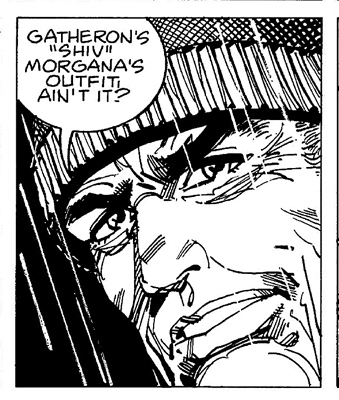Reviewed by Josh Bell ’02
[Comic book] During his nearly four decades as a comic book artist and writer, Walter Simonson has worked in genres ranging from science fiction to fantasy to horror—and of course on lots of superhero stories. He brings all of those genres (and more) together in his new centuries-spanning graphic novel The Judas Coin, which is probably the first comics work to feature prominent roles for both Jesus Christ and Batman. The former is the catalyst for the story, as his betrayal by his apostle Judas results in an accursed payment of 30 pieces of silver. One of those pieces, tainted with betrayal, shows up in the hands of various characters over the course of six chapters, each set in a different time period and drawn in a slightly different style.

Although The Judas Coin uses existing DC Comics characters to tell its stories, it’s not a jumbled superhero crossover or pandering team-up of popular characters. The only widely recognizable faces in the book belong to Batman and villain Two-Face; some chapters use obscure DC characters the Golden Gladiator, the Viking Prince, Captain Fear, Bat Lash and Manhunter 2070.
The coin shows up in different ways in each story, always present during moments of deceit or treachery. In the ancient Roman Empire, just 73 years after Christ’s death, it’s payment for a betrayal of Emperor Vespasian. Simonson draws the story of the emperor and the Golden Gladiator battling traitors in Germania in a clean, classical style, with well-defined panels and clear, concise action.
A thousand years later, the coin shows up as a talisman used by a barbaric pagan society to invoke a savage giant, against whom the Viking Prince does battle. Fans of Simonson’s seminal 1980s work on Marvel Comics’ Thor will recognize the intricate, almost baroque armor and weapons of the Viking characters, and the action in this story is propulsive and chaotic. Simonson switches gears again for the 18th-century story of pirate Captain Fear, betrayed by one of his own for a treasure that includes the cursed coin. The panel layout here is more sedate than in the Viking story, but still more fluid than in the Golden Gladiator chapter, and the subtle ways that Simonson alters his style are as effective as the bolder changes.
More sedate still is the visual style of the chapter featuring Western hero Bat Lash, who hands off the coin in a disputed card game. Simonson presents the story with rounded panel borders and a subdued palette from colorist Lovern Kindzierski, making it look almost like a faded early photograph.
The boldest visual change comes in the next chapter, a showdown between Batman and Two-Face at an exhibit of rare coins. Simonson structures this story like a series of newspaper strips, laid out horizontally and presented in black and white with red highlights (for blood). Snippets of news stories surround the panels, offering up exposition in a unique and unobtrusive fashion.
The book’s finale takes place in 2087, as spacefaring bounty hunter Manhunter 2070 tracks down two thieves who’ve stolen the coin. Simonson does an impressive job of combining familiar manga imagery (big eyes, speed lines, exaggerated facial expressions) with his own more traditional superhero-comics style, and along with the Viking segment, this final chapter is the most visually dynamic. The entire book is densely packed with action and drama, representing a dizzying ride through history and through the almost superhuman range of Simonson’s talents. As devious figures betray each other again and again, Simonson demonstrates the continuity of human experience (and the DC universe) with remarkable assurance and ingenuity.
Bell is the film editor of Las Vegas Weekly.